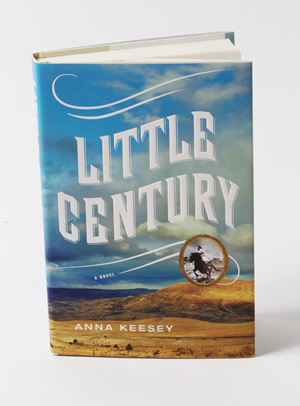Aisles
Danger in the High Desert
Little Century
by Anna Keesey
Review by Benjamin Craig

 like westerns. Western films, though—not novels. I’ve never had a taste for the novels. I’m put off by any clumsiness in the use of archaic language, and by overlong descriptions of landscape. But I grew up in the west—in rural Oregon—and like anyone else, I enjoy the familiarity of place that comes with reading something set in my backyard. Anna Keesey’s Little Century isn’t exactly set in my backyard—almost nobody lives in the Oregon high desert where Esther Chambers finds herself settling into life among cattle ranchers, sheepherders, and a quickly escalating war over the scarcest resource: water. That part is still true. The Oregon high desert is a desolate and lonely, though strikingly beautiful, place today, just as it was in the year the novel begins, 1900.
like westerns. Western films, though—not novels. I’ve never had a taste for the novels. I’m put off by any clumsiness in the use of archaic language, and by overlong descriptions of landscape. But I grew up in the west—in rural Oregon—and like anyone else, I enjoy the familiarity of place that comes with reading something set in my backyard. Anna Keesey’s Little Century isn’t exactly set in my backyard—almost nobody lives in the Oregon high desert where Esther Chambers finds herself settling into life among cattle ranchers, sheepherders, and a quickly escalating war over the scarcest resource: water. That part is still true. The Oregon high desert is a desolate and lonely, though strikingly beautiful, place today, just as it was in the year the novel begins, 1900.
I approached this novel hopeful of feeling a little of the comfort of the familiar place, and pessimistic about my chances of actually liking the book. I was happily wrong on both counts. Keesey’s spare descriptions of the high desert landscape and the characters that inhabit it made this place completely new for me. Her eye for detail and the nuance she gives to each character by describing their gait, bearing, and mannerisms create an easy and full world—one that quickly drew me away from any preconceptions I had about the place or the genre. As Esther learns more about Pick, the cousin who has taken her in, and Ben, the sheepherder who is his sworn enemy, her loyalty is tested and she is drawn into dangerous dealings and violent confrontations. This is all new territory for Esther, who previously lived with her mother in Chicago. Now eighteen and orphaned, she has been transplanted into what may as well be another country. The people of Century and the desert are inextricably linked together by growing, in Esther’s mind, more complicated and more dangerous in tandem.
Land grabs, lonely, brooding men, high desert, city women out of place—these are tropes of the western. There is nothing in this story or about these characters that transcends the genre, but Keesey accomplishes something rare here—she gives her readers keen insight into the motivations of her characters through her descriptions of place, without calling attention to metaphor or anthropomorphizing.
I sometimes find myself insufferable in my ability to be unsurprised by a novel, but this book surprised me—by doing nothing tricky, attempting nothing complicated. It’s Keesey’s skill with language—her simple sentences and paragraphs, the gentle and somber pace of the novel, and the flashes of keen insight into the desires that motivate her characters—that make this Oregon western a lovely read.
 Benjamin Craig is an editor at the magazine.
Benjamin Craig is an editor at the magazine.




